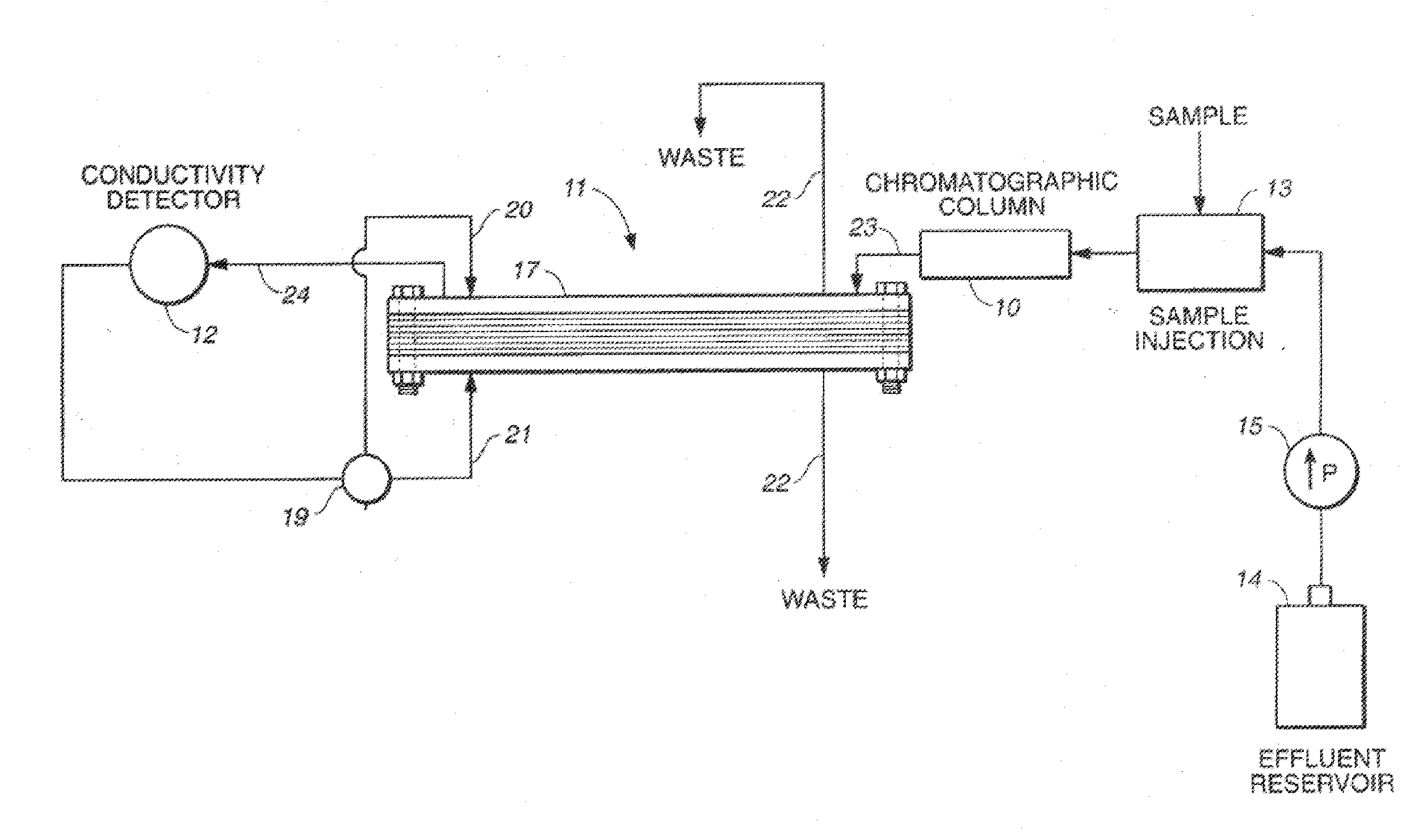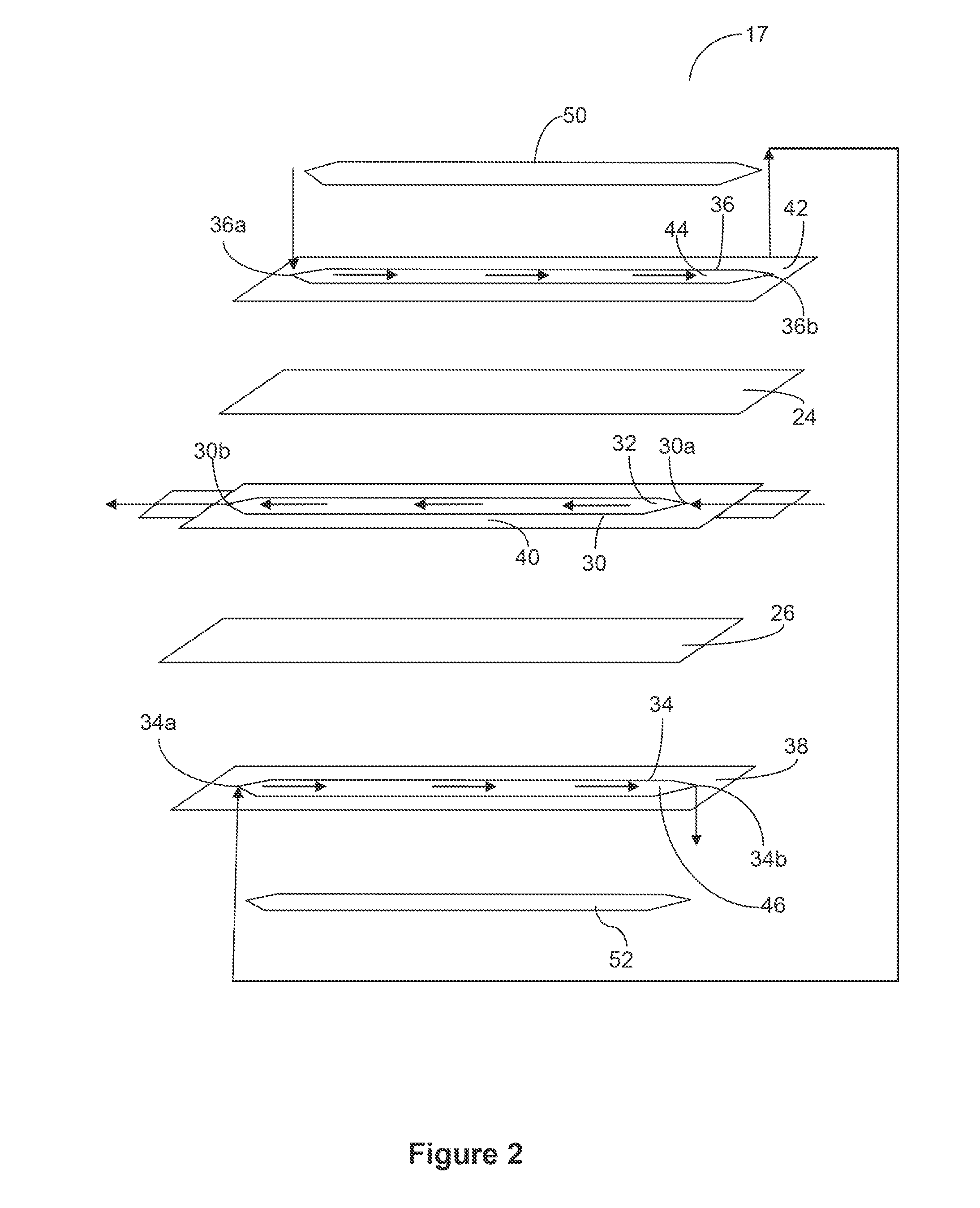Current efficient electrolytic device and method
a current efficient and electrolytic technology, applied in electrodialysis, diaphragms, refrigeration components, etc., can solve the problems of high background noise, high current, and heat generation
- Summary
- Abstract
- Description
- Claims
- Application Information
AI Technical Summary
Benefits of technology
Problems solved by technology
Method used
Image
Examples
example 1
[0059]A 4 mm anion self-regenerating suppressor (ASRS) was assembled and plumbed following the schematic of FIG. 2. A polystyrene divinyl benzene based sulfonated cation exchange resin that had 16% crosslinking was used. The capacity of this resin was 2.0 meqv / mL. Approximately 0.4 g of the resin was placed along the total length of the eluent sample stream channel in a dry form to provide a density of 1.62 grams / cc. Cationic ion exchange screens were placed in the regenerant channels. Once the device was assembled and the device was hydrated it was ready for use. The static capacity was measured and was roughly 2.0 meqv for the eluent channel that included the exchange capacity of the ion exchange membranes and the ion exchange resin. The static capacity calculated was 7.4 meqv / mL of the sample stream flow channel. The static capacity of a standard commercial suppressor sold under the name 4 mm ASRS 300 was roughly 270 μeqv. The static capacity calculated was approximately 1.0 meqv...
example 2
[0061]A 2 mm ASRS suppressor was assembled and plumbed following the schematic of FIG. 2. The cation exchange resin from example 1 was used in this example. Approximately 0.08 g of dry resin was placed along the length in the eluent channel in a dry form. Cationic ion exchange screens were placed in the regenerant channels. Once the device was assembled and the device was hydrated it was ready for use. The static capacity was measured and was roughly 0.4 meqv for the eluent channel that included the exchange capacity of the ion exchange membranes and the ion exchange resin. The static capacity calculated was 6.84 meqv / mL of the sample stream flow channel. The static capacity of a standard commercial suppressor sold under the name 2 mm ASRS 300 was roughly 55 μeqv. The device of the present invention had roughly a greater than 7 fold higher capacity than the prior art. The static capacity calculated for the commercial device was 0.81 meqv / mL of the sample stream flow channel. The dev...
example 3
[0063]A 4 mm cation self-regenerating suppressor (CSRS) was assembled and plumbed following the schematic of FIG. 2. The anion exchange resin used was AG1 resin, 8% crosslinked with a capacity of 1.2 meqv / mL (Particle diameter 45-106 μm) sold by Bio-Rad, Hercules, Calif. Approximately 0.4 g was placed along the eluent channel in a dry form. Anion exchange screens were placed in the regenerant channels. Once the device was assembled and the device was hydrated it was ready for use. The static capacity was measured and was roughly 1.8 meqv for the eluent channel that included the exchange capacity of the ion exchange membranes and the ion exchange resin. The static capacity of a standard commercial suppressor sold under the name 4 mm CSRS 300 was roughly 600 μeqv. The device of the present invention had roughly a greater than 3 fold higher capacity than the prior art. The device was used as a suppressor for cation analysis using an IonPac CS12A (4×250 mm) column from Thermo Fisher Sci...
PUM
| Property | Measurement | Unit |
|---|---|---|
| Fraction | aaaaa | aaaaa |
| Mass | aaaaa | aaaaa |
| Size | aaaaa | aaaaa |
Abstract
Description
Claims
Application Information
 Login to View More
Login to View More - R&D
- Intellectual Property
- Life Sciences
- Materials
- Tech Scout
- Unparalleled Data Quality
- Higher Quality Content
- 60% Fewer Hallucinations
Browse by: Latest US Patents, China's latest patents, Technical Efficacy Thesaurus, Application Domain, Technology Topic, Popular Technical Reports.
© 2025 PatSnap. All rights reserved.Legal|Privacy policy|Modern Slavery Act Transparency Statement|Sitemap|About US| Contact US: help@patsnap.com



